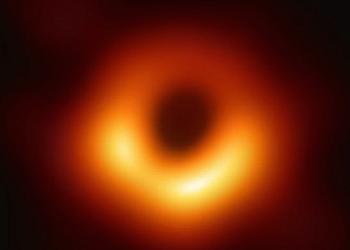
WASHINGTON, DC, April 11, 2019 (ENS) – An international team of scientists has for the first time captured an image of a black hole. Revealed Wednesday by researchers from the Event Horizon Telescope, the image shows a bright ring of material surrounding a dark center that marks the event horizon of the black hole – the “point of no return, where nothing, not even light – can escape.”
Black holes are compressed cosmic objects, containing incredible amounts of mass within a tiny region. Their presence affects their surroundings in extreme ways, by warping spacetime and super-heating any material falling into it.

The captured image reveals the black hole at the center of Messier 87, a massive galaxy in the constellation of Virgo. This black hole is located 55 million light-years from Earth and has a mass 6.5-billion times larger than our Sun.
The Event Horizon Telescope, a planet-scale array of eight ground-based radio telescopes forged through international collaboration, was designed to capture images of a black hole.
The eight telescopes are located at high-altitude sites, such as the Spanish Sierra Nevada, volcanoes in Hawaii and Mexico, mountains in Arizona, the Chilean Atacama Desert, and Antarctica. Synchronized with atomic clocks, they create a virtual telescope dish as large as the Earth itself.
More than 200 researchers from Europe, Americas and East Asia are participating in this international operation.
The breakthrough was announced Wednesday in a series of six papers published in a special issue of “The Astrophysical Journal Letters.”
“A black hole, if you looked at it naked … would be invisible,” said Sheperd Doeleman, director of the Event Horizon Telescope at a Washington, DC news conference attended by media from around the world. “It’s nature’s most amazing invisibility cloak.”
But taking a picture of something which allows no light to escape appears impossible – until it’s achieved.

“In a paradox of its own gravity,” Doeleman explained, “you wind up seeing it because all the gas and dust that’s attracted to it gets crushed into a smaller and smaller volume, causing it to heat up to hundreds of billions of degrees. So you wind up with a 3-D flashlight illuminating all the space-time around the black hole.”
“To do this, we worked for over a decade,” Doeleman said. “In April 2017, all the dishes in the Event Horizon Telescope turned and stared at a galaxy 55 million light years away called M87 and the supermassive black hole at its core, and we are delighted to be able to report to you today that we have seen what we thought was unseeable. We have seen and taken a picture of a black hole.”
Capturing an image of a black hole, project leaders said, is about more than getting the first glimpse of one of the most curious objects in the cosmos. It also opens the door to allowing astronomers and physicists to test Einstein’s theories of gravity and general relativity under the most extreme conditions in the universe.
Avery Broderick, a professor of physics and astronomy at the University of Waterloo and a faculty member at the Perimeter Institute for Theoretical Physics, said the image provided a key confirmation of Einstein’s theories.
“Every photon in these first EHT images began its journey in a churning maelstrom embedded in the most extreme environment in the universe – the vicinity of a black hole,” Broderick said.

“The radio waves we see in these first images orbited a black hole before beginning their 55 million-year journey toward us, and this results in the black shadow or silhouette cast by the event horizon,” he said.
“General relativity makes a clear prediction of both the size and shape of those features – the shadow should be circular,” Broderick explained. “However, as with all journeys of discovery, when we began this expedition of the mind, we did not know what we would find. Were Einstein wrong or the object at the heart of M87 not a black hole, its silhouette could have been very different … or simply missing.”
But the circular shadow exists, and Broderick says “general relativity has passed another crucial test, one spanning from the horizons to the stars.”
“This is a huge day in astrophysics,” said National Science Foundation, NSF, Director France Córdova. “We’re seeing the unseeable. Black holes have sparked imaginations for decades. They have exotic properties and are mysterious to us. Yet with more observations like this one they are yielding their secrets.”
“This is why NSF exists,” said Córdova. “We enable scientists and engineers to illuminate the unknown, to reveal the subtle and complex majesty of our universe.”
Copyright Environment News Service (ENS) 2019. All rights reserved.
